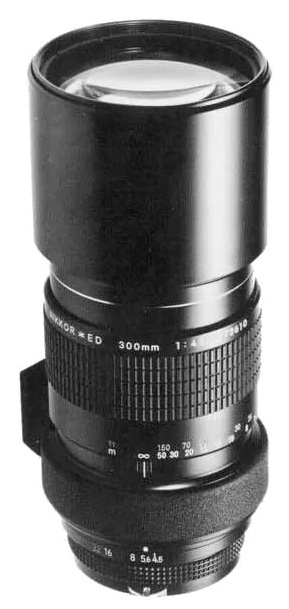Nikon Nikkor 300mm F/4.5 ED
Super telephoto prime lens • Film era • Discontinued
- Announced:
- · March 1977
- Production status:
- ● Discontinued
- Country of design:
- · Japan
- Original name:
- · Nikon NIKKOR*ED 300mm 1:4.5
- Class:
- · Slow full-frame super telephoto prime lens
- · Professional model
- System:
- · Nikon F (1959)
Abbreviations
| ED | The lens incorporates low dispersion elements. |
Model history (7)
| ■Nikon Nikkor 300mm F/4.5 ED | A | 6 - 4 | 4.00m | ⌀72 | 1977 ● | |
| ■Nikon AI Nikkor 300mm F/4.5 ED | A | 6 - 4 | 4.00m | ⌀72 | 1977 ● | |
| ■Nikon AI Nikkor 300mm F/4.5 IF-ED | A | 7 - 6 | 2.50m | ⌀72 | 1978 ● | |
| ■Nikon AI-S Nikkor 300mm F/4.5 IF-ED | A | 7 - 6 | 2.50m | ⌀72 | 1981 ● | |
| ■Nikon AF Nikkor 300mm F/4 IF-ED | A | 8 - 6 | 2.50m | ⌀82 | 1987 ● | |
| ■Nikon AF-S Nikkor 300mm F/4D IF-ED | A | 10 - 6 | 1.45m | ⌀77 | 2000 ● | |
| ■Nikon AF-S Nikkor 300mm F/4E PF ED VR | A | 16 - 10 | 1.40m | ⌀77 | 2015 ● | |
Specification
| Optical design: | |
| 35mm full frame | |
| 300mm | |
| F/4.5 | |
| 6 elements in 4 groups | |
| 2 ED | |
| Nikon F [46.5mm] | |
| 8.2° (35mm full frame) | |
| Diaphragm mechanism: | |
Diaphragm type: | Automatic |
Aperture control: | Aperture ring (Manual settings only) |
| 6 (six) | |
| Focusing: | |
| 4m | |
| <No data> | |
Focusing modes: | Manual focus only |
Manual focus control: | Focusing ring |
| Physical characteristics: | |
| 1100g | |
| ⌀78.5×192mm | |
| Accessories: | |
| Screw-type 72mm | |
| Built-in telescopic round | |
| <No data> |
Source of data
- Manufacturer's technical data.
Manufacturer description
The all-new 300mm f/4.5 ED-Nikkor lens, although externally almost identical to its non-ED sister model, offers a substantial improvement in optical performance for those demanding the best in telephoto photography. The 300mm f/4.5 ED-Nikkor features the use of Nippon Kogaku's newly developed "Extra-low Dispersion (ED) glass" for some of the lens elements to achieve a high level of chromatic aberration correction. The unique characteristic of this lens enable approximately 90% reduction of the secondary spectrum over the full 400 to 1000nm wavelength range; as a result, images are needle-sharp and full-contrast at all apertures, including full aperture. One added benefit with this lens is the excellent performance for infrared photography; with this model, infrared focus is identical to visual focus, thus eliminating the requirement for corrective refocusing as with other lens. Other lens features (e.g. the use of NIC on lens surfaces, the fully rotatable tripod mounting collar, etc.) are identical to those offered on the standard Nikkor 300mm f/4.5 lens; thus equipped, this lens offers the fullest ease of operation for the photographer.
From the editor
The effects of chromatic aberration begin to become significant at this focal length so Nikon launched this 300mm lens with ED glass that has a much-improved optical quality compared to the non-ED version. It was soon upgraded to the AI standard, however, it was still built with large helices that make focusing slow to operate.
Notes
- This non-AI lens was designed for Nikon F, F2, Nikkormat FS, FT, FT2, FTN, EL, ELW 35mm film SLR cameras.
- Non-AI lenses cannot be used on Nikon digital SLR cameras (except for the Df) or late (AI) film SLR cameras. However, non-AI lenses can be fitted to Nikon FM, FE, EL2, F3, F4 and Nikkormat FT3 cameras which used the AI metering system but allowed the metering coupling lever to be disengaged. The F5 could have this mechanism fitted as an optional extra. Non-AI lenses can be also fitted to the Nikon F2A and F2AS cameras because the AI mechanism was fitted to the removable metering prism.
